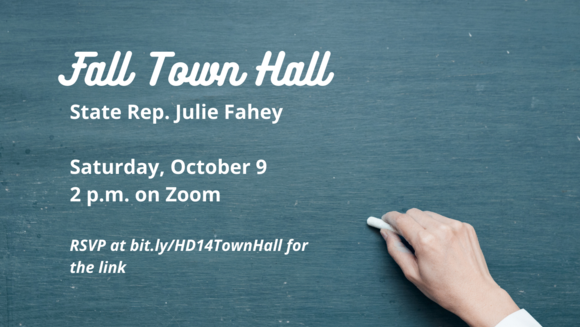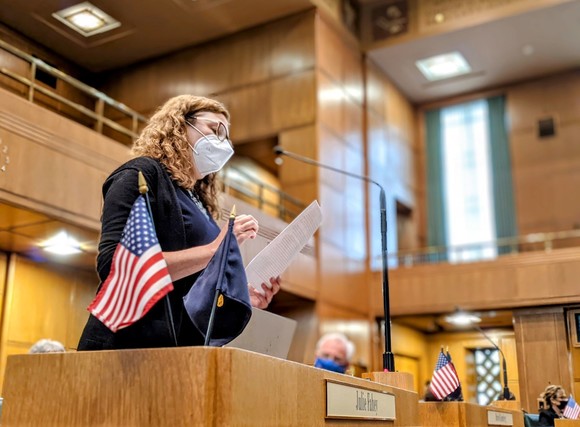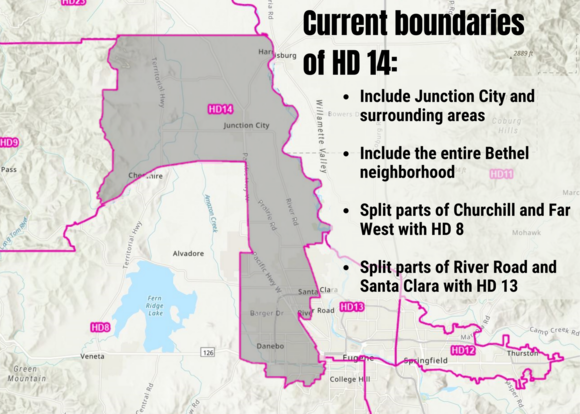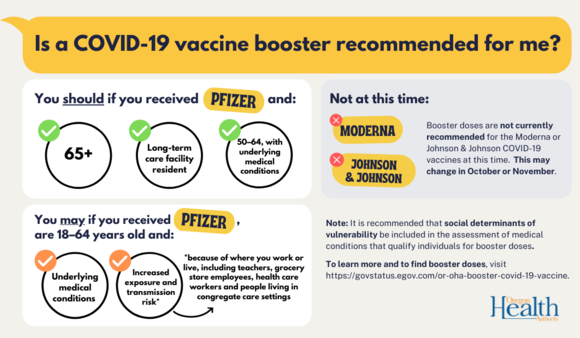|
Friends,
The legislature has completed our redistricting work, and fall is in the air. I’m holding my next town hall on Saturday, October 9, at 2 p.m., on Zoom. Bring your thoughts and questions about the new legislative maps, the upcoming 2022 legislative session, and any other issues on your mind. You can RSVP at this link, and we will send you the call-in information shortly before the event.

On Monday, the legislature successfully passed legislative and congressional district maps, with only hours to spare before the midnight deadline set by the Supreme Court. Every ten years following the U.S. Census, the legislature is responsible for redrawing congressional and state district lines to reflect the state’s population shifts. Over the past year, the legislative redistricting committees have been hard at work conducting hearings, discussing the growth and change Oregon has seen over the past ten years, and drawing draft maps for consideration.
The legislature first convened on Monday, September 20, for what was supposed to be a one- or two-day session to pass the maps. Instead, it was a bit of a wild ride trying to come to agreement, including a one-day walkout by House Republicans and a COVID diagnosis in the Capitol that shut things down for much of the week. In general, this has been a redistricting process like no other: the U.S. Census was significantly delayed by the pandemic, meaning that legislators had far less time than usual to consider the data and draw maps; Oregon’s population had grown enough that we were tasked with adding a sixth Congressional seat; and the Delta surge interfered with plans for in-person testimony. Still, there was significant public involvement in this process. The redistricting committees held 22 public hearings, and Oregonians have submitted nearly 2,000 pieces of public testimony about where they think the district lines should be drawn. This year is only the third time since 1911 that the legislature has succeeded in passing electoral maps – if we hadn’t met our deadline on Monday, the duty of drawing the lines would have gone to the Secretary of State and the courts.
 Speaking on the House floor about HD 14
So, after all of that, what do the maps look like? You can find PDFs of the new districts here or an interactive map of the new districts at this link (click on Content in the left sidebar, then expand Adopted Maps to select the Oregon House, Oregon Senate, or Congressional maps that were adopted by the legislature). The maps are designed to meet specific criteria as laid out by federal law, the Oregon constitution, and state law – they must be contiguous, of equal population, utilize existing geographic or political boundaries, be connected by transportation links, and reflect the diversity of communities of interest in our state.
I think House District 14 is a great example of how these new district lines were responsive to public testimony and better represent communities of interest than the current maps do. Right now, the Santa Clara and River Road neighborhoods are both split between HD 14 and HD 13, and Churchill and Far West are both split between HD 14 and HD 8. We heard plenty of testimony from Eugene residents this year about keeping neighborhoods whole as much as possible. So, the new maps will put all of Santa Clara and River Road in HD 13, and all of Churchill, Far West, Bethel, and Trainsong in HD 14.


These maps will go into effect for the 2022 election – so Oregonians are still in the old districts for now, but legislators/candidates will be running for the new districts at the next election.
Last week, the CDC and FDA authorized booster shots for some Americans who got the Pfizer BioNTech vaccine and who are especially vulnerable to COVID. Previously, additional doses had been available only to people with specific immunocompromising medical conditions, but they are now recommended for more of the general public. There has been a lot of confusion on this topic, so I wanted to lay out what Oregonians need to know right now.

Who is eligible for a booster shot? For most people, booster shots are only approved for people who received the Pfizer-BioNtech vaccine for their first two doses, and they can be administered six months or more after the person received their second shot. The CDC recommends that the following people should receive a booster shot, if they received the Pfizer vaccine for their first two doses and were vaccinated six or more months ago:
- People 65 and older
- People 18 and older in long-term care settings
- People 50-64 years old with underlying medical conditions that make them more susceptible to severe COVID-19 (medical conditions described here).
They recommend that the following groups may receive a booster shot based on their individual benefits and risks, if they received the Pfizer vaccine for their first two doses and were vaccinated six or more months ago:
- People 18-49 with underlying medical conditions
- People 18-64 who are at increased risk for COVID exposure and transmission because of where they work or live, including health care providers, grocery store workers, or people who live in congregate care settings (more information here).
In addition, people who are moderately or severely immunocompromised (such as people receiving cancer treatments, an organ or stem cell transplant, or who have an illness that affects their immune system) are also recommended to receive an extra dose – studies suggest that their immune systems do not respond as well to the vaccine. If you’re immunocompromised, the rules are a little different: you can get a third dose if you received either the Pfizer or Moderna vaccine for your first two doses, and you can receive the third dose 28 days after your second dose. You can read more information from the CDC here.
If you’re not sure whether you should get an additional dose of the vaccine, you should talk to your doctor or health care provider about your health concerns and exposure risk.
What if I got the Moderna or Johnson & Johnson Vaccine? People who received the Johnson & Johnson COVID-19 vaccines are not currently eligible to receive a booster. People who received the Moderna vaccine can receive a third dose if they are eligible because they are immunocompromised, but otherwise, Moderna boosters are not available yet. Federal health officials are studying data about the safety and effectiveness of boosters for Moderna and Johnson & Johnson, and they are expected consider a recommendation in coming weeks.
Why booster shots? The latest data shows that all three of the vaccines still offer strong protection against serious cases of COVID-19 for all ages, but that there has been a slight drop in effectiveness among the oldest adults. You are still protected and considered “fully vaccinated” if you haven’t gotten a booster shot, but if you’re especially vulnerable to COVID an extra shot can bolster the protection you already have. Studies indicate that getting a third shot of the Pfizer vaccine increases immune response, improving protection against COVID-19 and the Delta variant. Boosters are nothing new and are an important part of keep up the protections that vaccines provide – for instance, most people have received follow-up doses for the tetanus vaccine they got as kids.
How do I get my dose? Vaccines are available through doctor’s offices and local pharmacies. You can find vaccines through GetVaccinated.Oregon.Gov. In addition, Lane County Public Health has started holding booster vaccine clinics by appointment only. Visit their website or call 541-682-1380 for information and scheduling. According to state health officials, Oregon has plenty of vaccine doses, and everyone who is eligible to get a booster can get one. However, our health care system is still overwhelmed by the current Delta surge, so health care workers are asking for your patience.
I thought I’d close with a little good news for our region – Lane County has received a $3.3 million grant from the federal government to fund efforts to reduce youth homelessness! I’m looking forward to seeing how this funding will be put to use in our community.
Sincerely,
 Julie Fahey
State Representative
Capitol Phone: 503-986-1414
Capitol Address: 900 Court St. NE, H-286, Salem, Oregon 97301
Email: Rep.JulieFahey@oregonlegislature.gov
Website: http://www.oregonlegislature.gov/fahey
|